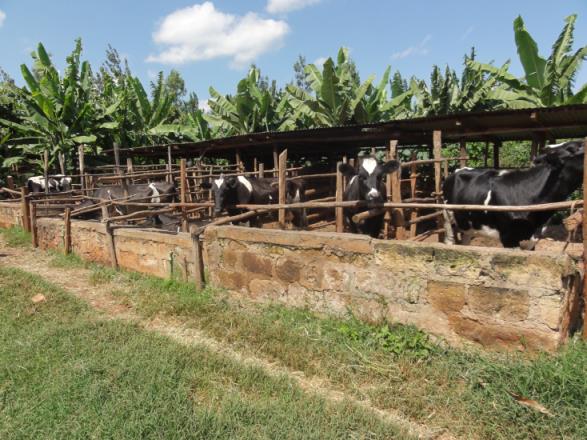Here is a comprehensive analysis of the benefits and challenges of zero-grazing dairy farming in Kenya, based on the provided search results.
🐄 Overview of Zero-Grazing Dairy Farming in Kenya
Zero-grazing is an intensive dairy farming system where cattle are confined in specially designed structures and fed with cut-and-carried fodder instead of being allowed to graze freely. This method has gained popularity in Kenya due to land scarcity, rising demand for milk, and the need for efficient resource management
Benefits of Zero-Grazing Dairy Farming
📈 Increased Milk Production
- Zero-grazing can boost milk yields by 40–83% compared to traditional grazing systems. Cows produce an average of 3,300 liters per year under zero-grazing, compared to 2,340 liters in semi-zero-grazing and 1,800 liters in open grazing .
- Controlled feeding and reduced energy expenditure (e.g., no walking to graze) allow cows to allocate more energy to milk production .
🏥 Improved Animal Health and Disease Control
- Confinement reduces exposure to tick-borne diseases, parasites, and infections common in open pastures .
- Farmers can closely monitor cattle for early signs of illness (e.g., mastitis) and implement timely veterinary care .
📊 Efficient Land Use
- Zero-grazing supports 4–5 cows per acre, compared to 1–2 cows in traditional systems, making it ideal for smallholder farmers with limited land .
- Fodder crops (e.g., Napier grass) can be grown on small plots and harvested rotationally for sustainable feed supply .
💧 Environmental Sustainability
- Manure is efficiently collected and used for biogas production or organic fertilizer, reducing environmental pollution .
- Prevents overgrazing, soil erosion, and degradation of pastures .
💰 Economic Advantages
- Higher milk yields generate steady income, with potential for year-round production .
- Manure sales and biogas production provide additional revenue streams .
🍶 Milk Quality and Safety
- Controlled environments reduce contamination risks, enabling cleaner milk production .
- Hygienic milking areas and better feed management enhance milk quality
⚠️ Challenges of Zero-Grazing Dairy Farming
High Initial Investment and Infrastructure Costs
- Constructing zero-grazing units (e.g., cubicles, feeding troughs, manure pits) requires significant capital. Costs range from KSh 80,000–300,000+ depending on size and complexity .
- Equipment like chaff cutters and milking machines add to upfront costs .
💪 Labor-Intensive Operations
- Daily tasks (fodder harvesting, feeding, cleaning, milking) demand 3–8 hours of labor per day, making it time-consuming and costly .
- Labor costs can consume 40–50% of operational budgets .
🌾 Feed Management Complexities
- Farmers must ensure year-round supply of high-quality fodder (e.g., Napier grass) and supplements .
- Droughts or pests can disrupt fodder production, forcing farmers to rely on expensive purchased feed .
🐮 Animal Welfare Concerns
- Confinement can cause stress, lameness, and hoof problems if housing is poorly designed .
- Inadequate space restricts natural behaviors like movement and social bonding .
🦠 Health Risks from Poor Management
- Unsanitary conditions (e.g., wet floors, manure buildup) increase risks of mastitis and bacterial infections .
- Incorrect feed ratios may lead to metabolic disorders like acidosis .
📚 Technical Knowledge Gaps
- Farmers need expertise in nutrition, breeding, and health management to avoid losses .
- Lack of training often results in suboptimal practices, such as improper housing dimensions or feed imbalances .
🌍 Environmental and Resource Pressures
- Manure accumulation can pollute water sources if not managed properly .
- High water demand (40–50 liters/cow/day) strains resources, especially in dry regions .
💡 Best Practices for Success
To maximize benefits and mitigate challenges, farmers should adopt the following strategies:
📐 Proper Housing Design: Ensure non-slip floors, adequate ventilation, and spacious cubicles (≥6–8 m²/cow) .
🌱 Rotational Fodder Planting: Maintain multiple plots of Napier grass or drought-resistant crops for continuous supply .
📊 Record Keeping: Monitor milk production, feed costs, and health records to optimize efficiency .
👩🔧 Training and Extension Services: Engage with experts for guidance on nutrition, breeding, and waste management .
💧 Manure and Water Management: Use manure for biogas/compost and install rainwater harvesting systems
Conclusion
Zero-grazing dairy farming offers transformative benefits for Kenyan farmers, including higher milk yields, better disease control, and efficient land use. However, it requires significant investment, labor, and technical knowledge to overcome challenges related to infrastructure, animal welfare, and resource management. With proper planning and adoption of best practices, zero-grazing can be a sustainable and profitable venture for smallholder and large-scale farmers alike.

